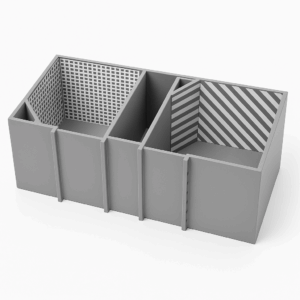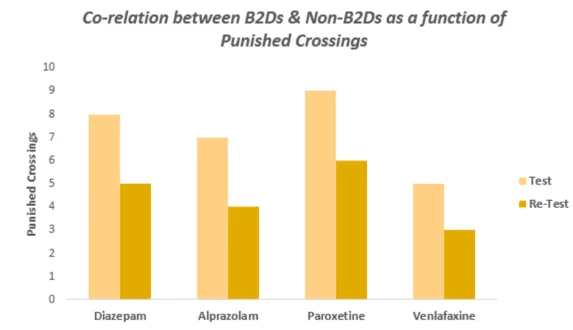$3,900.00 – $4,900.00Price range: $3,900.00 through $4,900.00
Aron’s test offers a sophisticated yet cost-effective method for assessing the impact of anxiolytic compounds in mice and rats. In this procedure, mild electric shocks are used to create a deterrent as the rodents explore a new environment. The MazeEngineers 4 Plate test provides precise control over shock administration, allowing for adjustable doses across four distinct quadrants. Data collection is seamlessly managed by our Conductor Software. Each order includes a user-friendly lid and optional interchangeable walls.
If needed, plates can be easily modified to switch from electrical shocks to heat plates. Please contact us for more information on this customization.

MazeEngineers empowers preclinical neuroscience research with meticulously designed, customizable behavioral apparatuses. From manual classic mazes to fully automated smart systems, we provide the tools scientists need to capture high-quality, reproducible data for studies on learning, memory, anxiety, and depression.



Mouse |
Length: 18cm |
Height: 25cm |
Height: 16cm |
Rat |
Length: 27cm |
Height: 37cm |
Height: 24cm |

Take advantage of Neuralynx, Ethovision Integration, SMS and Email integration with the Conductor Science Software. No I/O Boxes Required

The Aron test, also known as the four-plate test (FPT), is an animal model used to assess anxiety based on spontaneous behavior (Aron et al., 1971). In this test, the animal is placed in a new environment—a cage with four steel plates—where exploration is limited by the administration of mild electric foot shocks upon crossing from one quadrant to another. To avoid these shocks, the animal must remain stationary on one of the plates. The FPT relies on a passive avoidance mechanism, where mice are trained to cease movement to escape electric shocks (Boissier et al., 1968). This method is a straightforward model for studying conditioned fear.
The test also helps evaluate the anti-nociceptive effects of various compounds, which can either reduce anxiety or pain sensitivity in response to stressful stimuli like foot shocks. The FPT is particularly useful for observing the effects of antidepressants and other compounds in rodents before proceeding to human trials. It provides both quantitative and qualitative insights into how these substances perform under different dosages, injection sites, and environmental conditions.
The procedure is simple and effective: after an initial habituation period, the animal is subjected to electric shocks when it crosses from one plate to another—moving from two legs on one plate to two legs on another. The number of punished crossings is recorded over a 60-second period (Dunham and Mya, 1957). For instance, substances with anxiolytic effects typically increase the number of punished crossings, indicating reduced anxiety.
The Aron Test apparatus consists of a white plastic cage measuring 18 x 25 x 16 cm, equipped with a transparent Perspex lid to prevent the test animal from escaping. The cage floor features four identical rectangular metal (steel) plates, each measuring 8 x 11 cm, with 4 mm gaps between them. These plates are connected to an external unit that administers electric shocks.
The shock unit can deliver square pulses with an intensity ranging from 0 to 3 mA, for durations of 0 to 10 seconds. The unit requires manual operation to set the desired parameters.
For this test, Male Swiss mice (Janvier, France) (weighing on average 20 ± 2 g on the day of the study) were used in the original study, but any commonly used strain including C56BL/J can be used. Mice are typically housed in groups of 18 for a minimum of one week prior to experiments in plastic cages (44 cm × 30 cm × 17 cm) on 12:12 light/dark cycle and at a constant ambient temperature of 21±1°C and 50% humidity.
Depending on the requirement, the animal (mice) can be chosen to be naive or experienced (– if submitted to the test 24 hour previously) or both. The experimental groups are typically composed of 8-12 mice.
Following a brief habituation period of 15 seconds with the apparatus, subjects are subjected to electric shocks each time they cross from one plate to another.
The number of plate crossings is monitored and recorded over a 1-minute test duration (Dunham & Mya, 1957).
The testing protocol consists of two distinct sessions: the initial test (Session 1) and a retest (Session 2), which occurs 24 hours after the initial test.
Results from both sessions are compared to evaluate the overall performance and behavior of the mouse.
The subjects are randomly assigned to one of four groups for treatment. The first group receives saline for both the test and retest phases. The second group is given saline during the test phase and test treatment during the retest phase. The third group receives test treatment during the test phase and saline for the retest. The fourth group is administered test treatment for both the test and retest phases.
Saline or test treatment should be administered via the intraperitoneal route 30 minutes before the start of either the test or retest.
Another approach involves splitting subjects into two groups. In the first session (test/session 1), all subjects receive saline treatment. In the second session (retest/session 2), subjects can be given either saline or the test treatment.
As with the previous method, saline or test treatment should be administered via the intraperitoneal route 30 minutes prior to the test or retest.
The Hot Plate Test, introduced by Jacob et al. in 1974, mirrors the four-plate test paradigm but features a key modification: it uses heated plates as aversive stimuli instead of electric shocks.
This adaptation was made to address the inconsistent results observed with the four-plate test when using DOI.
The Hot Plate Test allows for adjustments in environmental conditions, compound dosages, injection sites, and test duration to suit specific research needs and objectives.
Data from the Aron or FPT test are typically represented through graphs that plot the number of punished crossings per minute in response to different compounds.
During the first session, subjects receive saline treatment, while in the retest session, they are administered various treatments.

It is evident from the above graph that all the treatments fail to decrease the levels of anxiety in the subjects during retesting. The possible reason may be the passive avoidance acquisition in subjects.
The four-plate test (FPT) is a straightforward and adaptable method, making it a valuable tool for assessing both anxiety and anti-nociceptive responses to various compounds.
One of the key benefits of the FPT is its ability to detect anxiolytic effects not only from benzodiazepines (BZDs) but also from non-BZD anxiolytic compounds such as selective serotonin reuptake inhibitors (SSRIs) (Hascoët et al., 2000).
This test can differentiate between changes in pain tolerance and the induction of anxiolytic effects resulting from specific treatments. It allows mice to learn passive avoidance behavior, even in cases where treatments do not influence memory.
When used in conjunction with other anxiety assessments, such as the hot-plate test, the FPT provides valuable insights into the neurotransmitter pathways involved in pain and aversive responses.
Punishment in the FPT leads to significant behavioral inhibition and enhanced learning (Hascoët et al., 1997), which means that results from test-retest protocols may vary.
While BZDs and antidepressants typically produce opposing effects in naïve versus experienced mice in the FPT, prior exposure to the FPT can diminish or eliminate the anxiolytic efficacy of BZD receptor agonists, similar to other anxiety models.
The modified FPT may struggle to distinguish between the anxiolytic effects of BZDs and those of antidepressants.
| Species | Mouse, Rat |
|---|
There are no questions yet. Be the first to ask a question about this product.